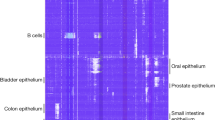Abstract
Histone methylation is involved in the regulation of gene expression and DNA replication through alteration of chromatin structure. We earlier showed that SMYD3, a histone H3-lysine 4-specific methyltransferase, is frequently upregulated in human colorectal, liver and breast cancer compared to their matched non-cancerous cells, and that its activity is associated with the growth of these tumors. In the present study, we found that human cancer cells express both the full-length and a cleaved form of SMYD3 protein. Amino acid sequence analysis uncovered that the cleaved form lacks the 34 amino acids in the N-terminal region of the full-length protein. Interestingly, the cleaved protein and mutant protein containing substitutions at glycines 15 and 17, two highly conserved amino acids in the N-terminal region, revealed a higher histone methyltransferase (HMTase) activity compared to the full-length protein. Furthermore, the N-terminal region is responsible for the association with heat shock protein 90α (HSP90α). These data indicate that the N-terminal region plays an important role for the regulation of its methyltransferase activity and suggest that a structural change of the protein through the cleavage of the region or interaction with HSP90α may be involved in the modulation. These findings may help for a better understanding of the mechanisms that modulate the HMTase activity of SMYD3, and contribute to the development of novel anticancer drugs targeting SMYD3 methyltransferase activity.
This is a preview of subscription content, access via your institution
Access options
Subscribe to this journal
Receive 50 print issues and online access
$259.00 per year
only $5.18 per issue
Buy this article
- Purchase on Springer Link
- Instant access to full article PDF
Prices may be subject to local taxes which are calculated during checkout





Similar content being viewed by others
References
Cao R, Wang L, Wang H, Xia L, Erdjument-Bromage H, Tempst P et al. (2002). Role of histone H3 lysine 27 methylation in Polycomb-group silencing. Science 298: 1039–4103.
Fasulo L, Ugolini G, Visintin M, Bradbury A, Brancolini C, Verzillo V et al. (2000). The neuronal microtubule-associated protein tau is a substrate for caspase-3 and an effector of apoptosis. J Neurochem 75: 624–633.
Fontecave M, Atta M, Mulliez E . (2004). S-adenosylmethionine: nothing goes to waste. Trends Biochem Sci 29: 243–249.
Greiner D, Bonaldi T, Eskeland R, Roemer E, Imhof A . (2005). Identification of a specific inhibitor of the histone methyltransferase SU(VAR)3–9. Nat Chem Biol 1: 143–145.
Hamamoto R, Furukawa Y, Morita M, Iimura Y, Silva FP, Li M et al. (2004). SMYD3 encodes a histone methyltransferase involved in the proliferation of cancer cells. Nat Cell Biol 6: 731–740.
Hamamoto R, Silva FP, Tsuge M, Nishidate T, Katagiri T, Nakamura Y et al. (2006). Enhanced SMYD3 expression is essential for the growth of breast cancer cells. Cancer Sci 97: 113–118.
Jacobs SA, Harp JM, Devarakonda S, Kim Y, Rastinejad F, Khorasanizadeh S . (2002). The active site of the SET domain is constructed on a knot. Nat Struct Biol 9: 833–838.
Jenuwein T, Allis CD . (2001). Translating the histone code. Science 293: 1074–1080.
Kouzarides T . (2002). Histone methylation in transcriptional control. Curr Opin Genet Dev 12: 198–209.
Lachner M, Jenuwein T . (2002). The many faces of histone lysine methylation. Curr Opin Cell Biol 14: 286–298.
Marmorstein R . (2003). Structure of SET domain proteins: a new twist on histone methylation. Trends Biochem Sci 28: 59–62.
Peterson CL, Laniel MA . (2004). Histones and histone modifications. Curr Biol 14: R546–R551.
Rawlings ND, Morton FR, Barrett AJ . (2006). MEROPS: the peptidase database. Nucleic Acids Res 34: D270–D272.
Tresaugues L, Dehe PM, Guerois R, Rodriguez-Gil A, Varlet I, Salah P et al. (2006). Structural characterization of Set1 RNA recognition motifs and their role in histone H3 lysine 4 methylation. J Mol Biol 359: 1170–1181.
Tsuge M, Hamamoto R, Silva FP, Ohnishi Y, Chayama K, Kamatani N et al. (2005). A variable number of tandem repeats polymorphism in an E2F-1 binding element in the 5′ flanking region of SMYD3 is a risk factor for human cancers. Nat Genet 37: 1104–1107.
Varambally S, Dhanasekaran SM, Zhou M, Barrette TR, Kumar-Sinha C, Sanda MG et al. (2002). The polycomb group protein EZH2 is involved in progression of prostate cancer. Nature 419: 624–629.
Yang XJ . (2005). Multisite protein modification and intramolecular signaling. Oncogene 24: 1653–1662.
Zhang X, Tamaru H, Khan SI, Horton JR, Keefe LJ, Selker EU et al. (2002). Structure of the Neurospora SET domain protein DIM-5, a histone H3 lysine methyltransferase. Cell 111: 117–127.
Acknowledgements
We thank Dr Kiyoshi Yamguchi for helpful discussions and Ms Yuka Yamane for technical assistance. This work was supported in part by a Grant-in-Aid for Scientific Research from the Ministry of Education, Culture, Sports, Science and Technology, Japan.
Author information
Authors and Affiliations
Corresponding author
Additional information
Supplementary Information accompanies the paper on the Oncogene website (http://www.nature.com/onc).
Supplementary information
Rights and permissions
About this article
Cite this article
Silva, F., Hamamoto, R., Kunizaki, M. et al. Enhanced methyltransferase activity of SMYD3 by the cleavage of its N-terminal region in human cancer cells. Oncogene 27, 2686–2692 (2008). https://doi.org/10.1038/sj.onc.1210929
Received:
Revised:
Accepted:
Published:
Issue Date:
DOI: https://doi.org/10.1038/sj.onc.1210929
Keywords
This article is cited by
-
The Global Relationship between Chromatin Physical Topology, Fractal Structure, and Gene Expression
Scientific Reports (2017)
-
Residual expression of SMYD2 and SMYD3 is associated with the acquisition of complex karyotype in chronic lymphocytic leukemia
Tumor Biology (2016)
-
Critical roles of non-histone protein lysine methylation in human tumorigenesis
Nature Reviews Cancer (2015)
-
Cancer as a dysregulated epigenome allowing cellular growth advantage at the expense of the host
Nature Reviews Cancer (2013)
-
Overexpression of the JmjC histone demethylase KDM5B in human carcinogenesis: involvement in the proliferation of cancer cells through the E2F/RB pathway
Molecular Cancer (2010)



